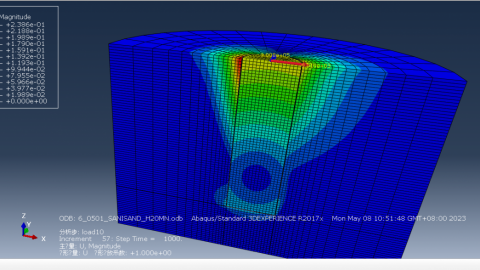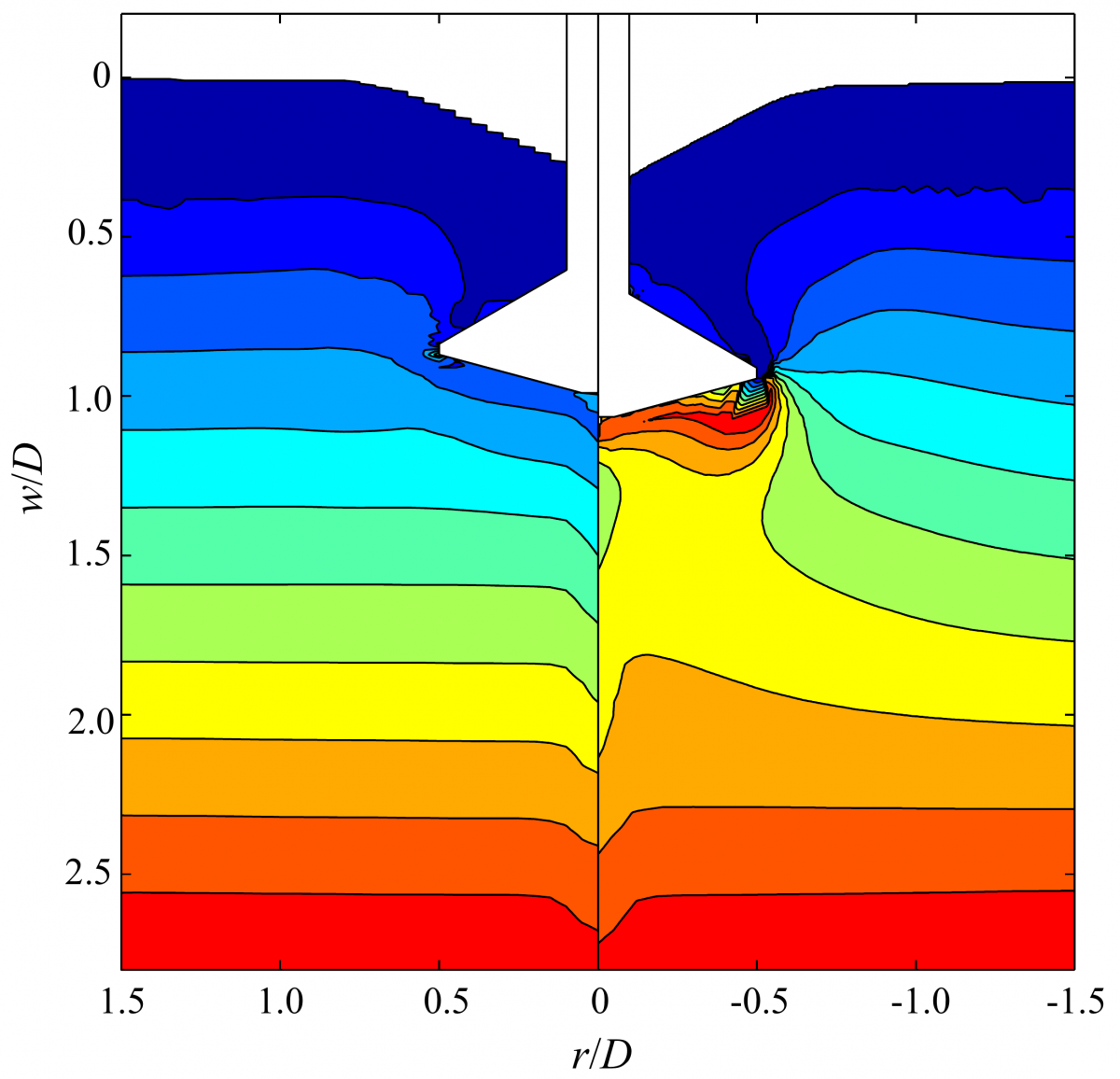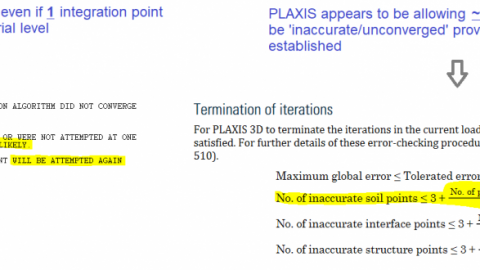I am trying to calibrate my sand using Excalibre. I tried some triaxial element tests using Abaqus. However the results are different between Excalibre and Abaqus.
Calibrate hypoplastic model
Related Articles
-
An error in the SANISAND umat runtime
 Zhentao Liu||Finite Elements|15 |Views 1,848
Zhentao Liu||Finite Elements|15 |Views 1,848
Dear all I was simulating a pile in a fully drained soil subjected to horizontal loads using ABAQUS (as shown in Figure 1) and noticed from the monitor that the […] -
Tochnog Professional overview movie in youtube
 Dennis Roddeman||Finite Elements|0 |Views 3,274
Dennis Roddeman||Finite Elements|0 |Views 3,274
Dear All, We posted a small overview movie of Tochnog Professional in YouTube. For more movies see the complete channel. -
new hypoplasticity laws in Tochnog Professional
 dennis roddeman||Finite Elements|1 |Views 3,332
dennis roddeman||Finite Elements|1 |Views 3,332
The 2014 Masin hypoplasticity for clays has been implemented in Tochnog Professional under guidance of Dr. David Masin. This implementation includes structure, intergranular strains and visco effects. Extensions to the […] -
Presentations on hypoplasticity applications, D. Mašín, NGI 2017
 David Mašín||Finite Elements|0 |Views 5,022
David Mašín||Finite Elements|0 |Views 5,022
Based on some requests, I share here two presentations on hypoplasticity applications. One is related to simulation of various boundary value problems, the other focuses on simulation of cyclic and […] -
How to replicate results for vertical cut in FEM program
 Amine Aboufirass||Finite Elements|0 |Views 3,487
Amine Aboufirass||Finite Elements|0 |Views 3,487
The equations for a vertical cut in cohesive material are given in several publications including Heyman (1973): The stability of a vertical cut (see attachment Equations1.jpeg) and Verruijt (2001) Soil […] -
UMAT Implementation in Abaqus (Hypoplastic clay Subroutines)
 Lovinder Mann||Finite Elements|3 |Views 3,752
Lovinder Mann||Finite Elements|3 |Views 3,752
Hi, I am working in Abaqus, aiming to model double porosity clay consolidation data by using hypoplastic clay model with meta stable structure. First, i just wanted to verify basic […] -
problem with sanisand umat
 yousef zand||Finite Elements|8 |Views 3,660
yousef zand||Finite Elements|8 |Views 3,660
Dear all, I’m trying to model multilayer soil in abaqus. To use the SaniSand umat in model I use the following parameters but no plastic strain at all. The unit […] -
Abaqus vs Plaxis – Local Convergence Tolerances
 Sina Azad||Finite Elements|1 |Views 4,737
Sina Azad||Finite Elements|1 |Views 4,737
Hi, I have a question regarding local, material-level convergence tolerances in FE software, particularly Abaqus and Plaxis. I have experience using Abaqus but not much familiar with Plaxis. As shown […]
Who is Online
No one is online right now
Search SoilModels Website
Recent posts
-
 Degradation ( disturbance ) of hypoplastic clay 23.4.2024
Degradation ( disturbance ) of hypoplastic clay 23.4.2024
-
 Degradation ( disturbance ) of hypoplastic clay 23.4.2024
Degradation ( disturbance ) of hypoplastic clay 23.4.2024
-
 Paper of Coulomb, C. A. (1773) 15.4.2024
Paper of Coulomb, C. A. (1773) 15.4.2024
-
 ABAQUS UMAT of hypoplastic clay model 6.4.2024
ABAQUS UMAT of hypoplastic clay model 6.4.2024
-
 Prague Geotechnical Days 2024 “Geotechnical monitoring” and 30th jubilee Prague Geotechnical Lecture by prof. Eduardo Alonso 5.4.2024
Prague Geotechnical Days 2024 “Geotechnical monitoring” and 30th jubilee Prague Geotechnical Lecture by prof. Eduardo Alonso 5.4.2024
-
 UMAT for Creep-SCLAY model. 1.3.2024
UMAT for Creep-SCLAY model. 1.3.2024
-
 Cyclic tests with Triax element test driver 14.2.2024
Cyclic tests with Triax element test driver 14.2.2024
-
 SUMMER SCHOOL ‘Numerical Modelling in Geotechnical Engineering’, Innsbruck – July 22nd-26th, 2024 1.2.2024
SUMMER SCHOOL ‘Numerical Modelling in Geotechnical Engineering’, Innsbruck – July 22nd-26th, 2024 1.2.2024
-
 COURSE IN SOIL MODELING – NTNU, Trondheim – October 14th to 18th, 2024 21.12.2023
COURSE IN SOIL MODELING – NTNU, Trondheim – October 14th to 18th, 2024 21.12.2023
-
 MSE walls design in Plaxis 11.12.2023
MSE walls design in Plaxis 11.12.2023
-
 sand liquefaction modelling in Anura3D 8.12.2023
sand liquefaction modelling in Anura3D 8.12.2023
-
 BCV bentonite experimental and modelling datasets 14.11.2023
BCV bentonite experimental and modelling datasets 14.11.2023
Recent Comments
- Gertraud Medicus on ABAQUS UMAT of hypoplastic clay model
- Chen Zhiming on Download Package of Charles University Implementation of High Cycle Accumulation Model
- Konstantinos Chatzis on Cyclic tests with Triax element test driver
- Abhay Pratap Singh on Cyclic tests with Triax element test driver
- Giovanni Ciardi on Cyclic tests with Triax element test driver
- Konstantinos Chatzis on Cyclic tests with Triax element test driver
- Ismail Khan on Cyclic tests with Triax element test driver
- Kanika Lamba on Cyclic tests with Triax element test driver
- Arie Koot on How to model the settlement in soil due to water drawdown.
- Konstantinos Chatzis on Cyclic tests with Triax element test driver
- Jose Duque on Cyclic tests with Triax element test driver
- MohamadReza Kamali on How to model the settlement in soil due to water drawdown.
- Leo Alibert on MSE walls design in Plaxis
- Ignacio Zuloaga on MSE walls design in Plaxis
- Giada Orlando on Problem with VUMAT interface
- Michael Spyridis on Problem with VUMAT interface
- Ahmad Moeineddin on Problem with VUMAT interface
- Nikolay Suyo Calla on Hardening soil Model UMAT







Hi Sahar, please also check the initial void ratio for triaxial tests indicated by excalibre. This is the only issue I can think about, otherwise you have some error in Abaqus input.
Hi David, this is the input file for my abaqus model. This input file is for the sand example “lapProtocalTemplate-Sand” shared on Excalibre automatic calibration page. I got the hypoplastic parameters from Excalibre and input them into Abaqus. The peak of deviatoric stress-strain curve from Abaqus is much higher than the experimental curve and the Excalibre curve. I can’t find the mistake in my input.
*Heading
** Job name: CD-50-Excalibre-Sample-Sand Model name: CD-50-Excalibre-Sample-Sand
** Generated by: Abaqus/CAE 2016
*Preprint, echo=NO, model=NO, history=NO, contact=NO
**
** PARTS
**
*Part, name=Part-1
*Node
1, 0., 0.
2, 0.100000001, 0.
3, 0., 0.100000001
4, 0.100000001, 0.100000001
5, 0.0500000007, 0.
6, 0.100000001, 0.0500000007
7, 0.0500000007, 0.100000001
8, 0., 0.0500000007
*Element, type=CAX8
1, 1, 2, 4, 3, 5, 6, 7, 8
*Nset, nset=Set-1, generate
1, 8, 1
*Elset, elset=Set-1
1,
*Nset, nset=top-n
3, 4, 7
*Nset, nset=bot-n
1, 2, 5
*Nset, nset=axis
1, 3, 8
** Section: Section-1
*Solid Section, elset=Set-1, material=Material-1
,
*End Part
**
**
** ASSEMBLY
**
*Assembly, name=Assembly
**
*Instance, name=Part-1-1, part=Part-1
*End Instance
**
*Elset, elset=EL, instance=Part-1-1
1,
*Elset, elset=_Surf-1_S2, internal, instance=Part-1-1
1,
*Elset, elset=_Surf-1_S3, internal, instance=Part-1-1
1,
*Surface, type=ELEMENT, name=Surf-1
_Surf-1_S2, S2
_Surf-1_S3, S3
*End Assembly
**
** MATERIALS
**
*Material, name=Material-1
*Density
1.0927,
*Depvar
13,
*User Material, constants=16, unsymm
36.5, 1.,49846., 0.243, 0.572, 1.144, 1.372, 0.09
4.5, 0., 0., 0., 0., 0., 0., 0.51
**
** BOUNDARY CONDITIONS
**
** Name: axis-bc Type: Displacement/Rotation
*Boundary
Part-1-1.axis, 1, 1
** Name: bot-bc Type: Displacement/Rotation
*Boundary
Part-1-1.bot-n, 2, 2
** Name: top-bc Type: Displacement/Rotation
*Boundary
Part-1-1.top-n, 2, 2
**
** PREDEFINED FIELDS
**
** Name: Predefined Field-1 Type: Geostatic stress
*Initial Conditions, type=STRESS, GEOSTATIC
Part-1-1.Set-1, -50., 0.1, -50., 0., 1., 1.
** Name: Predefined Field-2 Type: Void ratio
*Initial Conditions, TYPE=RATIO
Part-1-1.Set-1, 0.51
** —————————————————————-
**
** STEP: Step-1
**
*Step, name=Step-1, nlgeom=NO
*Geostatic
**
** LOADS
**
** Name: Load-1 Type: Pressure
*Dsload
Surf-1, P, 50.
**
** OUTPUT REQUESTS
**
*Restart, write, frequency=0
**
** FIELD OUTPUT: F-Output-1
**
*Output, field
*Node Output
U,
*Element Output, directions=YES
E, S
**
** HISTORY OUTPUT: H-Output-1
**
*Output, history, variable=PRESELECT
*End Step
** —————————————————————-
**
** STEP: Step-2
**
*Step, name=Step-2, nlgeom=NO, inc=1000
*Static
0.001, 1., 1e-15, 1.
**
** BOUNDARY CONDITIONS
**
** Name: top-bc Type: Displacement/Rotation
*Boundary
Part-1-1.top-n, 2, 2, -0.05
**
** LOADS
**
** Name: Load-1 Type: Pressure
*Dsload
Surf-1, P, 50.
**
** OUTPUT REQUESTS
**
*Restart, write, frequency=0
**
** FIELD OUTPUT: F-Output-1
**
*Output, field
*Node Output
U,
*Element Output, directions=YES
E, S
**
** HISTORY OUTPUT: H-Output-1
**
*Output, history, variable=PRESELECT
*End Step